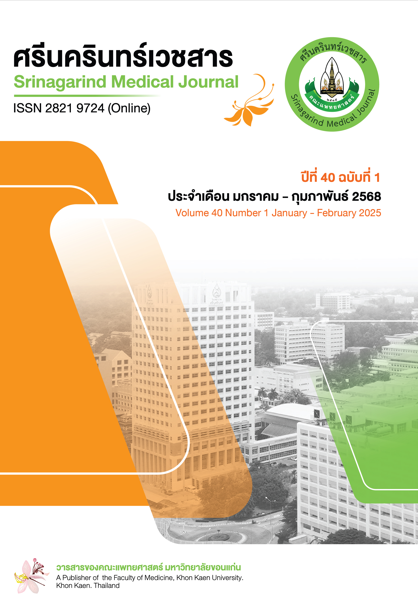ระดับฟอสเฟตในเลือดหลังเปลี่ยนโหมดการล้างไตทางหน้าท้องจากแบบต่อเนื่องตลอดเวลาเป็นแบบใช้เครื่องอัตโนมัติ
คำสำคัญ:
ฟอสเฟตในเลือด, โรคไตเรื้อรังระยะสุดท้าย, การล้างไตทางหน้าท้องโดยใช้เครื่องอัตโนมัติ, การล้างไตทางหน้าท้องแบบต่อเนื่องตลอดเวลาบทคัดย่อ
หลักการและวัตถุประสงค์: ประเทศไทยมีจำนวนผู้ป่วยโรคไตเรื้อรังระยะสุดท้ายที่ล้างไตทางหน้าท้องโดยใช้เครื่องอัตโนมัติเพิ่มขึ้น (automated peritoneal dialysis; APD) แต่ยังขาดข้อมูลระดับฟอสเฟตในเลือดเปรียบเทียบกับการล้างไตทางหน้าท้องแบบต่อเนื่องตลอดเวลา (continuous ambulatory peritoneal dialysis; CAPD) ฟอสเฟตเป็นของเสียที่มีโมเลกุลขนาดใหญ่ที่อาจถูกขับออกได้ไม่เต็มที่ ซึ่งหากฟอสเฟตในเลือดสูงขึ้นอาจทำให้เกิดผลเสียตามมา เช่น ความผิดปกติของกระดูกและภาวะหลอดเลือดแดงแข็ง ดังนั้นการศึกษานี้จึงมีวัตถุประสงค์เพื่อศึกษาเปรียบเทียบระดับฟอสเฟตในเลือดของผู้ป่วยโรคไตเรื้อรังระยะสุดท้าย ก่อนและหลังเปลี่ยนโหมดการล้างไตทางหน้าท้องจากแบบ CAPD เป็นแบบ APD
วิธีการศึกษา: ศึกษาย้อนหลังจากเวชระเบียนผู้ป่วยโรคไตเรื้อรังระยะสุดท้ายที่เปลี่ยนโหมดการล้างไตทางหน้าท้องจากแบบ CAPD เป็นแบบ APD ระหว่างเดือนกรกฎาคม พ.ศ. 2562 ถึงมิถุนายน พ.ศ. 2567
ผลการศึกษา: ผู้ป่วยโรคไตเรื้อรังระยะสุดท้ายที่เปลี่ยนจาก CAPD เป็น APD มีจำนวน 31 ราย ส่วนใหญ่เป็นเพศหญิงร้อยละ 52 อายุเฉลี่ย 59.0 ± 14.4 ปี โดยร้อยละ 90.3 เป็นโรคความดันโลหิตสูงและร้อยละ 51.6 เป็นโรคเบาหวาน หลังเปลี่ยนโหมดการล้างไตพบว่าระดับฟอสเฟตในเลือดเพิ่มขึ้นอย่างมีนัยสำคัญจาก 4.3 เป็น 6.1 มก./ดล. (p < 0.001)
สรุป: การเปลี่ยนโหมดการล้างไตทางหน้าท้องจากแบบ CAPD เป็น APD ในผู้ป่วยโรคไตเรื้อรังระยะสุดท้ายสัมพันธ์กับระดับฟอสเฟตในเลือดที่เพิ่มขึ้นอย่างมีนัยสำคัญ จึงควรมีการติดตามระดับฟอสเฟตอย่างใกล้ชิดในผู้ป่วยที่ล้างไตทางหน้าท้องแบบ APD
References
Bargman JM, Thorpe KE, Churchill DN. Relative contribution of residual renal function and peritoneal clearance to adequacy of dialysis: a reanalysis of CANUSA study. J Am Soc Nephrol 2001;12(10):2158-62. doi:10.1681/ASN.V12102158.
Heaf JG, Løkkegaard H, Madsen M. Initial survival advantage of peritoneal dialysis relative to haemodialysis. Nephrol Dial Transplant 2002;17(1):112-7. doi:10.1093/ndt/17.1.112.
Schwenger V, Döhler B, Morath C, Zeier M, Opelz G. The role of pretransplant dialysis modality on renal allograft outcome. Nephrol Dial Transplant 2011;26(11):3761-6. doi:10.1093/ndt/gfr132
Shah A, Hashmi MF, Aeddula NR. Chronic kidney disease-mineral bone disorder (CKD-MBD). In: Stat Pearls [Internet]. Treasure Island (FL): StatPearls Publishing; 2024. [cited Oct 10, 2024] Available from: https://pubmed.ncbi.nlm.nih.gov/32809577/
Goodman WG, Goldin J, Kuizon BD, Yoon C, Gales B, Sider D, et al. Coronary-artery calcification in young adults with end-stage renal disease who are undergoing dialysis. N Engl J Med 2000;342(20):1478-83. doi:10.1056/NEJM200005183422003
Rufino M, de Bonis E, Martin M, Rebollo S, Martin B, Miguel R, et al. Is it possible to control hyperphosphataemia with diet, without inducing protein malnutrition? Nephrol Dial Transplant 1998;13(Suppl 3):65–7. doi:10.1093/ndt/13.suppl_3.65.
Sperschneider H, Gunther K, Marzoll I, Kirchner E, Stein G. Calcium carbonate (CaCO3): an efficient and safe phosphate binder in haemodialysis patients? A 3-year study. Nephrol Dial Transplant 1993;8(6):530–4. doi:10.1093/ndt/8.6.530.
Wang AY, Woo J, Sea MM, Law MC, Lui SF, Li PK. Hyperphosphatemia in Chinese peritoneal dialysis patients with and without residual kidney function: What are the implications? Am J Kidney Dis 2004;43(4):712–20. doi:10.1053/j.ajkd.2003.12.032
Debowska M, Gomez R, Pinto J, Waniewski J, Lindholm B. Phosphate clearance in peritoneal dialysis. Sci Rep 2020;10(1):17504. doi:10.1038/s41598-020-74412-2.
Ansell D. Serum phosphate and outcomes in PD patients. Nephrol Dial Transplant 2007;22(2):667–8. doi:10.1093/ndt/gfl593.
Noordzij M, Korevaar JC, Bos WJ, Boeschoten EW, Dekker FW, Bossuyt PM, et al. Mineral metabolism and cardiovascular morbidity and mortality risk: peritoneal dialysis patients compared with haemodialysis patients. Nephrol Dial Transplant 2006;21(9):2513–20. doi: 10.1093/ndt/gfl257.
Downloads
เผยแพร่แล้ว
How to Cite
ฉบับ
บท
License
Copyright (c) 2025 ศรีนครินทร์เวชสาร

This work is licensed under a Creative Commons Attribution-NonCommercial-NoDerivatives 4.0 International License.



